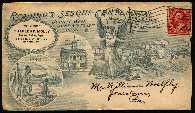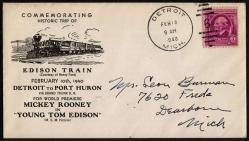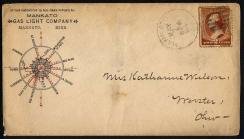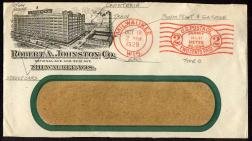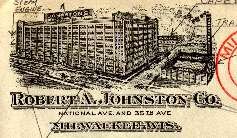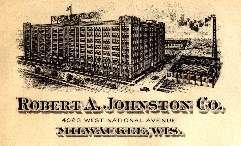Previous page --- HOME --- Next page


Trains on US Advertising Covers and Patriotic Covers
Page 5
These are just covers that don't quite fit into any of the other categories. But don't
assume they are mundane or ordinary! There are some gems here. My favorite is the first
one, for the Reading, PA Sesquicentennial of 1898, though the postmark is 1901 - "Waste
not, Want not!"
The price I paid for that one ($125) shows you how much I liked it. And not only
does it have the wonderful steam train,
The cover above (three versions), from Eastman's Business College of Poughkeepsie, NY,
is astonishing for the elaborate and (to me) irrelevant image. I suppose one could say
there is a connection between a business college and the elements in the lower right -
the train, harbor, and factories are certainly related to business; but as one moves
left and upward the theme becomes entirely allegorical and patriotic, and today seems
absurd. Note however, that this same image, without the ad, was used by Charles Magnus
on one of his Civil War Patriotics -
click here to see that
cover - and while the postmark on the center cover is illegible, the stamp is Scott
65, issued 1861, in the set of new issues necessitated by the demonitization of all prior
US stamps at the start of the War Between the States; so the College was presumably
expressing its patriotism. Note that the designs of the covers on the sides are closer
to the Magnus original. The one on the right is clearly dated 1864, while the one on the
left has a pencilled "1866".
I was able to find many historical references to Eastman's Business College in the
Internet -
here is an interesting and typical one, including a little history of the school
- with dates ranging from the 1860's to the 1890's, and including some
famous names
so apparently its self-praise was not hyperbole.
This web page
says the school was founded in 1859.
Above is an image from one of the school's catalogs, circa 1880, courtesy of
I love the cover above, though its condition leaves a lot to be desired. Still, the
advertising design is complete and clear, and includes a fine, though tiny, train, and
the inscription "Travelling in their own special train of Pullman Palace Cars". The
Dodge City Cowboy Band were once, apparently, household words. Founded around 1880, they
performed at the inauguration of Benjamin Harrison, in 1889, and were still in business
in 1902, if the postmark on this cover can be trusted. Here is a
link to an excellent history of the group, and
here is a
photo of the band from the fascinating site of the
Ford County Historical Society, Dodge City, Kansas.
The cover above might be called an event cover or commemorative cover, rather than an
advertising cover,
The cover on the right above is Canadian, but I include it here because of the
similarity in the two designs. The cover on the left (May 7, 1885, Scott 210) shows a
stylized map with spokes representing railroad lines (their initials in red) from
Mankato, Minn. to major cities in all directions, presumably to convey the message that
the Mankato Gas Light Company could deliver its products overnight by train to all those
locations (which I find puzzling - was gas not distributed by pipes in those days?) The
cover on the right (Sept. 7, 1904, Scott 90), uses a ship's wheel in a similar fashion,
with its spokes representing the routes of various railroads. I note that some of the
railroad initials are repeated, and suspect that was just to fill all the spokes
(apparently a ship's wheel must have eight), but possibly it was done because the
directions really are intended as points on the compass, and the routes ran that way.
Here is
a well-designed and entertaining site about Mankato.
And here is
the only link I could find that mentions "Mankato Gas Light Company", with this
intriguing but ambiguous sentence:
"1890, Mankato Gas and Light Company, rather than the Mankato Gas Light Company is
granted the right to service Mankato. "
This cover shows a horse-drawn streetcar, rather than a train, but I am including it
because I find the image and text so entertaining. Mailed Sept. 20, 1890, and bearing a
copy of Scott 220, the cover was sent from the Dr. H W Wood Chemical Laboratory of
Sedalia, MO. The text running vertically at right reads "With 70 to 100 travelling
salesmen all the time on the road". The text running vertically on the left (cut off,
unfortunately) reads "One of the largest pill manufacturing..." We can guess it went on
"factories in the world!" The flag flying at top reads "Wood's Opera House", so
apparently Dr. Wood was a patron of the arts. The opera house no longer exists, but is
known on the Internet as
MYSTERY COVER
There?s a mystery here. I assume the corner card was personal, rather than commercial. "Kantrip" must be the last name
of the sender. Yet he had NJ preprinted on the envelope along with the image, so maybe it is a business. Is he saying
that he is content to cruise along on his bicycle while the world speeds by on a train? The postmark is illegible, but
the date must be in the early 1890's, as the stamp is Scott 219, issued 2/22/1890. Can anyone solve the mystery?
7/17/04 - I sold this item on eBay, and the buyer, a former resident of Tenafly,
offered this:
ANYONE ELSE?
I got hotel cover cheaply, so its odd condition, neither mint nor used, with just the
inked notations that imply to me it was hand-delivered, perhaps at the hotel, was OK.
I'd prefer it with a nice contemporary stamp and postmark, to date it, of course. But
with two steam trains AND an electric trolley, it was a nice addition to my collection.
The seller dated it "1880's", which is plausible.
The first three of these owe their inclusion to the meter itself, since there would be
no train otherwise. The last two could go into the Stores and Factories group above, but
I decided they belonged here.
Click on the last image above and look at the enlarged version - a prior owner annotated
the illustration. I might have missed that tiny steam engine at the far left. I have
five examples of this cover, dated from 1927 through 1932. The illustration on the last
of them, from 1932, is slightly different - click on the thumbnails below to see high-res
images of the two versions.
This is like one of those kids' puzzles - Can You Find the Differences? What made them
produce the new version? The trees have grown a little, the autos are newer, but that's
all I can see. Perhaps it was the new address.
And what did Robert A. Johnston Co. do? The collector I acquired these from wrote on
his album page that the company "Manufactured Candy Boxes", but I think he was only
partly right - I think
they
manufactured candy.
It puzzles me that they would have said nothing on their envelopes about what their
business was - perhaps their name was such a household word at the time that they felt it
wasn't necessary.
MISCELLANEOUS
it is also an advertising collar, another topic
I collect, though you have to look closely to see the collar.
the web site of the Rare Book, Manuscript, and Special Collections Library, Duke
University,
with more of the same imagery, so at least Eastman was consistent.
but the movie plug persuades me its purpose was advertising.
the place where Scott Joplin's The Ragtime Dance was first performed in 1899.
I cannot solve the mystery. However, I grew up in Tenafly, NJ and I know that Mr
Demarest was a very influential man in the early history of the town. He owned the
hardware store, which still bears his name.

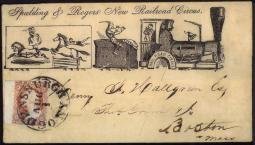
These two are images from auction catalogs - both items had hefty prices. I do not own
them.
METERS
Previous page --- HOME --- Next page
All text Copyright © 2001, William M. Senkus
Send feedback to the webmaster: CLICK HERE
Revised -- 01/24/2003
